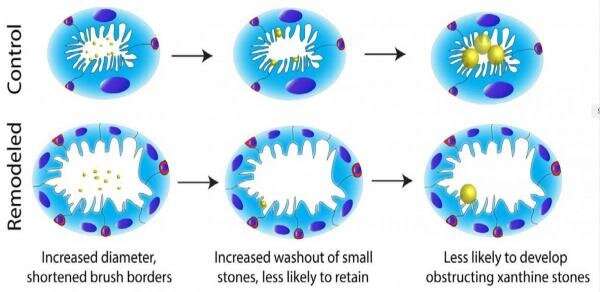An illustration showing the remodeling that renal stem cells undertake in fruit fly Malpighian tubules following a bout of kidney stones. Credit: Allan Spradling
Recent work from Carnegie's Chenhui Wang and Allan Spradling reveals a surprising capability of renal stem cells in fruit flies—remodeling. Their work, which could eventually guide kidney stone treatments, was published by Science Advances.
Stem cells are the raw materials from which our bodies are formed.
The ultimate utility player, embryonic stem cells are capable of differentiating into any cell type to construct any organ or tissue in the body. Adult stem cells' abilities are not quite so unlimited. They exist within a specific tissue—such as the skin or the intestinal lining—and are responsible for renewing it following injuries, stress, and environmental damage.
"A tissue's structure and function can be maintained by adult stem cells throughout an organism's life," Spradling said. "Until now, we thought that was the limit of what adult stem cells could accomplish."
However, Spradling and Wang made a remarkable discovery in studying the adult stem cells that are found in a fruit fly tissue responsible for waste removal called the Malpighian tubule, which is analogous to the human kidney.
"We found that the renal stem cells in the fruit fly Malpighian tubule do actual remodeling work—responding to a bout of kidney stones by widening the area to prevent future blockages," explained Wang, who did this work as a postdoc at Carnegie and is now an assistant professor at Shanghai Tech University. He added: "We found that these alterations are irreversible. The remodeled state becomes the new normal for this tissue."
In an effort to better understand this startling stem cell capability, Spradling and Wang searched for side effects of the remodeling efforts. They showed that a post-kidney stone Malpighian tubule makeover was accompanied by an increased sensitivity to salt and reduced fertility.
"Because Malpighian tubules are one of the few fruit fly tissues that remain largely unchanged from their larval state, we think that these renal stem cells remain in a kind of holding pattern and are only spurred into action when the tubules are damaged by kidney stones or something else," Spradling said.
He and Wang believe that similar "makeover-capable" stem cells are likely common in other tissues, but are difficult to find, because they only demonstrate their abilities under specific conditions.
"Similar stem cells could exist in human kidneys," Wang concluded. "Deepening our knowledge of how these newly discovered 'makeover' stem cells work in fruit flies might someday advance our ability to treat and prevent kidney stones, which are a growing medical issue around the world."
More information: Chenhui Wang et al, Drosophila renal stem cells enhance fitness by delayed remodeling of adult Malpighian tubules, Science Advances (2022). DOI: 10.1126/sciadv.abn7436
Journal information: Science Advances
Provided by Carnegie Institution for Science























